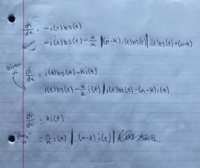I'm not sure how many of you would be familiar with the SIR Model of Epidemics, but I'm having trouble trying to adjust some equations given a new parameter.
The original parameters are: t=time, N=total population, b= a fixed # of contacts/day that spread the disease is the other person is susceptible, k =1/avg length of disease (average # of days a person is infected, S(t)=# of susceptible people, I(t)=# of infected people, and I(t)=# of infected people. Where s(t)=S(t)/N, i(t)=I(t)/N, and r(t)=R(t)/N and are fractions of the total population.
It also assumes that when a person has recovered, they do not become susceptible again and that N is constant (no new people arrive and no one dies)
The equation for the rate of change for s(t) is: ds/dt = −i(t)bs(t)
The equation for the rate of change for i(t) is : di/dt = i(t)bs(t)−ki(t)
And the equation for the rate of change for r(t) is: dr/dt = ki(t)
The question says to consider a disease where immunity is lost and to adjust these ROC equations to the new parameter n, which is the amount of days after recovery when the person because susceptible again.
I'm sorry for any confusion, but any help on adjusting these equations would be awesome!
The original parameters are: t=time, N=total population, b= a fixed # of contacts/day that spread the disease is the other person is susceptible, k =1/avg length of disease (average # of days a person is infected, S(t)=# of susceptible people, I(t)=# of infected people, and I(t)=# of infected people. Where s(t)=S(t)/N, i(t)=I(t)/N, and r(t)=R(t)/N and are fractions of the total population.
It also assumes that when a person has recovered, they do not become susceptible again and that N is constant (no new people arrive and no one dies)
The equation for the rate of change for s(t) is: ds/dt = −i(t)bs(t)
The equation for the rate of change for i(t) is : di/dt = i(t)bs(t)−ki(t)
And the equation for the rate of change for r(t) is: dr/dt = ki(t)
The question says to consider a disease where immunity is lost and to adjust these ROC equations to the new parameter n, which is the amount of days after recovery when the person because susceptible again.
I'm sorry for any confusion, but any help on adjusting these equations would be awesome!

